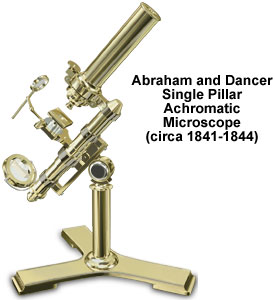Abraham and Dancer Single Pillar Microscope
The Abraham and Dancer single pillar microscope is an early example of a compound monocular achromatic microscope. The illustration of the instrument featured below was developed from images in Gerard Turner's Collecting Microscopes, a volume in Christie's International Collectors Series of books on antiques.

John B. Dancer was an optician and mathematical instrument maker, but is most often remembered as the inventor of photomicrographs and the stereoscopic camera, or as the father of microfilm, although he never secured any patents. From 1841 to 1845, however, he produced single pillar, achromatic microscopes in conjunction with a colleague, Abraham Abraham. The instrument presented above is an example of their cooperative efforts and consists of a single brass pillar mounted on a Y-shaped tripod base. A pivot located at the top of the pillar is used for instrument inclination, and a single body tube mounted in a brass collar holds the achromatic objective and eyepiece. The limb of the microscope is straight and holds a small, rotatable square stage, a substage condenser, and the body tube assembly. Beneath the stage, a light-gathering mirror is mounted on a gimbal and supported at the bottom of the limb. A Lieberkühn reflector attached to the substage by an articulated arm assists in the illumination of opaque specimens. The original model of the undated microscope is signed "Abraham & Dancer, Manchester", and is housed in the collection of the Museum of the History of Science in Oxford.
After their partnership dissolved, Dancer continued to produce microscopes and other scientific instruments from his workshop in Manchester, England, while Abraham returned to his home in Liverpool, where he headed the firm of Abraham and Company until 1860. Dancer, who had apprenticed under the great optics pioneers Jesse Ramsden, John Dalton, and Edward Troughton, went on to create high quality instruments for many prominent scientists, such as James J. Joule, William B. Carpenter, and John Dalton. His independent productions were initially double pillar microscopes, but he then switched to a design similar to that of Smith & Beck before developing binocular microscopes of his own design.
BACK TO NINETEENTH CENTURY MICROSCOPES
